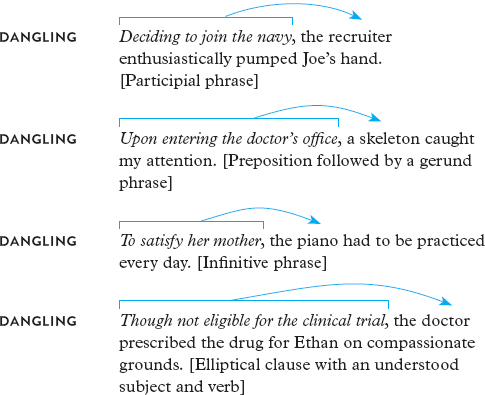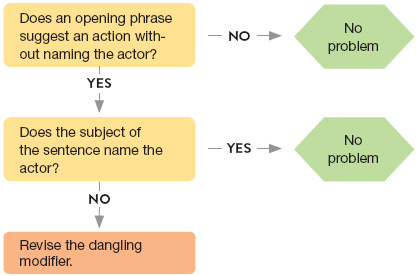12e. Dangling modifiers
A dangling modifier fails to refer logically to any word in the sentence. Dangling modifiers are easy to repair, but they can be hard to recognize, especially in your own writing.
Recognizing dangling modifiers
Dangling modifiers are usually word groups (such as verbal phrases) that suggest but do not name an actor. When a sentence opens with such a modifier, readers expect the subject of the next clause to name the actor. If it doesn’t, the modifier dangles.

The framers of the Constitution (not the document itself) understood the need for checks and balances.

Women (not their access to the priesthood) complete the training.
The following sentences illustrate four common kinds of dangling modifiers.

These dangling modifiers falsely suggest that the recruiter decided to join the navy, that the skeleton entered the doctor’s office, that the piano intended to satisfy the mother, and that the doctor was not eligible for the clinical trial.
Although most readers will understand the writer’s intended meaning in such sentences, the inadvertent humor can be distracting. The following flowchart will help you recognize dangling modifiers in your writing.

Repairing dangling modifiers
To repair a dangling modifier, you can revise the sentence in one of two ways:
- Name the actor in the subject of the sentence.
- Name the actor in the modifier.
Depending on your sentence, one of these revision strategies may be more appropriate than the other.
actor named in subject


actor named in modifier


note: You cannot repair a dangling modifier just by moving it. Consider, for example, the sentence about the skeleton. If you put the modifier at the end of the sentence (A skeleton caught my attention upon entering the doctor’s office), you are still suggesting—absurdly, of course—that the skeleton entered the office. The only way to avoid the problem is to put the word I in the sentence, either as the subject or in the modifier.


hackerhandbooks.com/bedhandbook
- Clear sentences > Exercises: 12–2 to 12–5